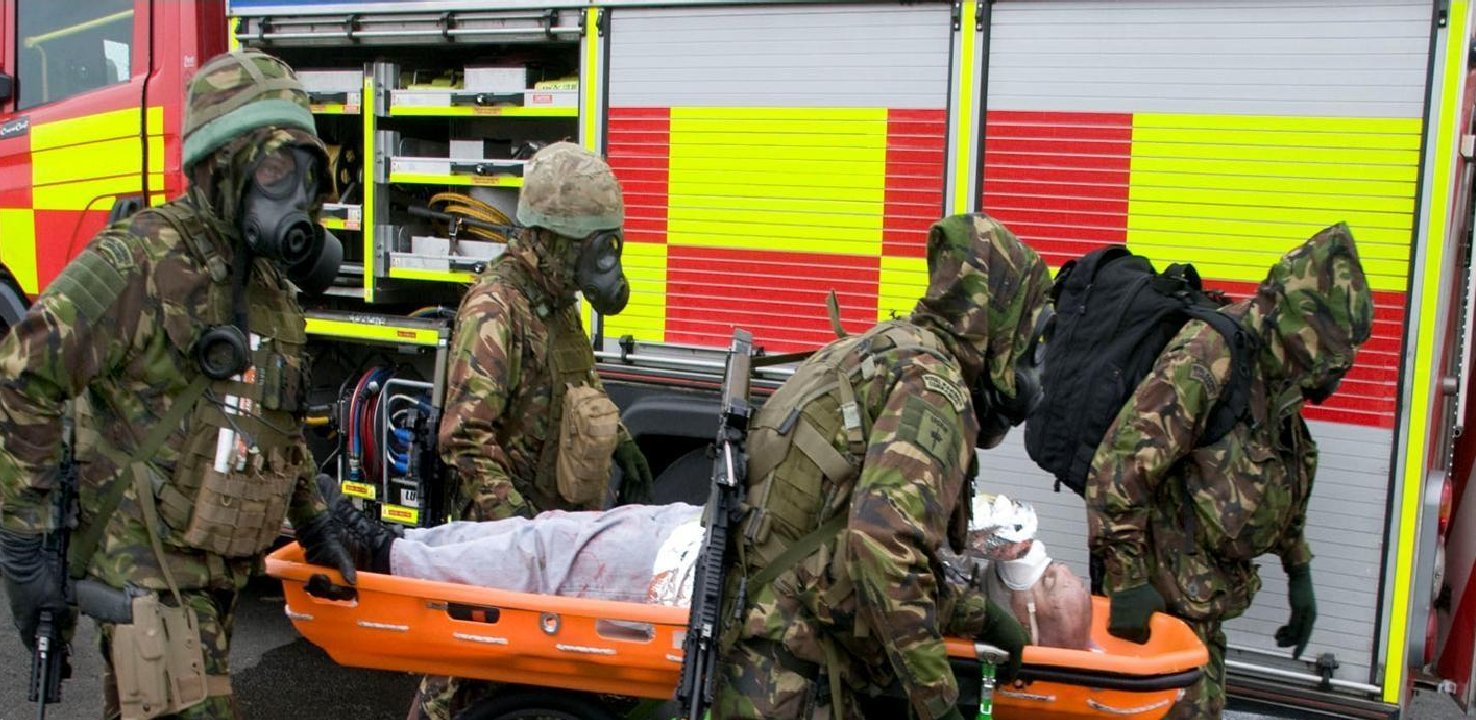Ministry of Defence personnel recover a casualty during a nuclear emergency exercise
A series of mistakes, delays, and communication failures revealed in official assessment reports for nuclear emergency exercises have raised questions over the Ministry of Defence (MoD)'s ability to respond effectively to an accident involving a nuclear weapon.
The reports reveal that mistakes made by emergency responders would have led to “avoidable deaths” in a real-life situation, and that press briefings intended to inform the public and media about one emergency "substantially understated the scale of the hazards". MoD safety regulators were so concerned about the problems exposed by another exercise that they called for “an overarching, fundamental review” of nuclear emergency response arrangements.
The reports, prepared by the MoD's internal Defence Nuclear Safety Regulator (DNSR) to assess exercises for rehearsing arrangements to deal with an accident during the transport of nuclear weapons, were released to the Ferret news agency following a request made under the Freedom of Information Act. The documents are available to download at the end of this article.
Two of the exercises involved scenarios where aircraft carrying nuclear materials crashed, spreading radioactive contamination around the accident site. Both were codenamed Astral Bend, one taking place at the Caerwent exercise area in South Wales on 24 February 2011 and the other at Heyford Park in Oxfordshire on 27 March 2012.
At the 2011 exercise there were disagreements over how to deal with radioactively contaminated casualties. The South Wales Fire and Rescue Service was criticised by DNSR for refusing to allow ambulance teams to take away seriously injured people until they had been decontaminated, claiming that this “would, in the event of such an incident, lead to avoidable deaths”.
Technical advice provided by MoD experts to the emergency services during the exercise was deemed to be of poor quality. There was a “lengthy delay” before the MoD incident commander liaised with emergency services and a "lack of effective SNT [Station NARO Team] command level liaison" which led to a "lack of understanding of the hazard by the fire service". Bronze level (on-site) command and control was poor and "struggled throughout" on technical issues.
MoD incident commanders were judged to “lack the background knowledge of the hazards of radioactive materials" because their training is "inadequate" as a key training course course has been abolished because of cutbacks.
At a mock media briefing during Astral Bend 2011 questions were “not well handled, in particular substantially understating the scale of the hazards ”, the assessment report said.
Similar problems were experienced at a repeat exercise a year later. During the Astral Bend 2012 exercise in Oxfordshire the time taken for MoD to respond to the emergency was raised as an issue because drills and orders were "not optimised” and had the “potential to delay the most effective elements of the response". There was a “lack of urgency” in deploying the MoD response team and a helicopter transporting the team to the emergency site was delayed in taking off by Air Traffic Control. As a result, responders from civilian emergency services would have been contaminated with radioactive material because they were forced to take action before MoD advisers had provided detailed hazard information.
At a media briefing there was “an unfortunate ambiguity” about whether radioactive contamination had been detected and what precautions had been advised.
The third exercise rehearsed the response to an accident involving the nuclear weapons convoy that regularly transports warheads back and forth between the Atomic Weapons Establishment in Berkshire and HM Naval Base Clyde. The exercise was called Astral Climb and took place on 15 November 2012 at Albemarle barracks in Northumberland.
During the exercise MoD personnel travelling with the convoy prevented fire and ambulance services from getting to casualties for 40 minutes when their help was “critically required”. The DNSR report concluded that: “This may have contributed to the number of fatalities within the exercise”. The reasons the convoy personnel acted as they did have been redacted from the document released.
There were “delays and a lack of urgency” in rescuing casualties, and flaws in the way they were handled. The report stated that “the role of the convoy medic was unclear and the provision of medical equipment was not adequate.”
In possibly the most damning admission of all, the report concluded that the MoD's response strategy and drills for nuclear convoy and air transport emergencies "require an overarching fundamental review". According to the answer to a Parliamentary Question asked by Paul Flynn MP this review was not completed until 2015 – three years after the concerns had been identified.
MoD told The Ferret that convoy operations are conducted “to the strictest safety standards”.
“We always take into account factors such as road and weather conditions and consult with all relevant local agencies, including traffic agencies and the police. In over 50 years of transporting nuclear material by road in the UK, there has never been an incident that has presented any risk to the public or to the environment”, said an MoD spokesperson.
Download the DNSR assessment reports here:
